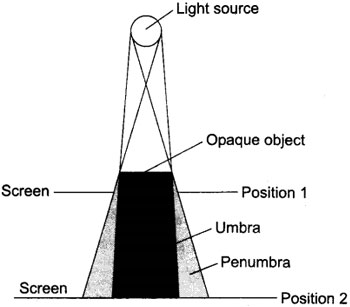Question: Draw a diagram to illustrate the formation of umbra and penumbra.
Answer:

Question: What are the essential conditions for the formation of shadow?
Answer:
- There should be an opaque material.
- There should be a source of light and screen.
The object must be placed in the path of light. Then shadow is formed on the screen.
Question: Define reflection of light.
Answer: When light rays after striking the smooth and shiny surface return to same medium, this phenomenon is called reflection of light.
Question: How will you convert a glass sheet into a translucent sheet?
Answer: There are following two methods to convert glass sheet into a translucent sheet:
- By smearing a thin layer of oil on glass sheet.
- By covering a side of sheet by butter paper.
Question: What is shadow? How does the colour of an opaque object affects the colour of the shadow?
Answer: A dark outline or patch formed by an opaque object that blocks light coming from a source of light is called shadow. The colour of an opaque object does not affect the colour of the shadow.
Question: Write the differences between umbra and penumbra.
Answer:
Umbra:
- It is the darkest part of shadow.
- No light reaches to this region.
- It is central part of a shadow.
Penumbra:
- It is less dark part of shadow.
- Light from some part of the source reaches.
- It is outer part of a shadow.
Question: What do we need in order to see a shadow?
Answer: We need:
- A source of light
- A screen
- An opaque object.
Question: What do you mean by scattering of light?
Answer: When a beam of light falls on a rough surface it is turned back in different directions. It is called scattering of light.
 Class Notes NCERT Solutions for CBSE Students
Class Notes NCERT Solutions for CBSE Students


